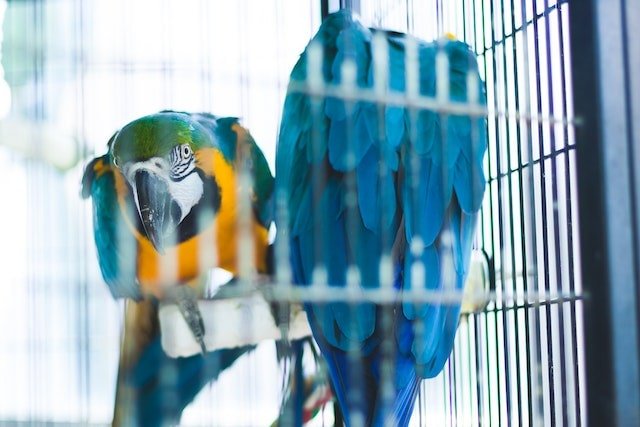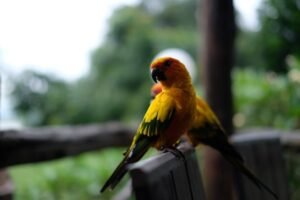Checking your parrot’s dropping is not the most pleasant idea, but it can tell you a lot about their health. The color of your parrot’s feces can provide insights into their health and help you take the appropriate action.
Normally, your parrot’s stools should be olive in color, soft, and free from any unpleasant odors. However, if your parrot passes blood-tinged droppings, it could indicate underlying health problems.
Blood in a parrot’s poop may be associated with injuries in the lower rectum or internal bleeding caused by health conditions such as stomach ulcers, intestinal parasites, and egg binding. The parrot may also have accompanying symptoms like lethargy, depression, abdominal pain, loss of appetite, etc.
Quick Navigation
What Does Healthy Parrot Poop Look Like?
Before we talk about the cause of blood in parrot poop, let us first understand what healthy droppings look like in parrots. Parrot poop typically consists of three main components – Fecal (solid waste), Urate (semi-solid waste), and Urine (liquid).
The color of healthy droppings is between the shades of green and brown though it can vary, depending on the diet and the food they recently ate.
The feces component is usually dark brown or greenish-brown, while the urates are white. It’s important to note that parrot droppings can have some variation throughout the day based on their diet.
Melena In Parrots
Melena is a condition characterized by dark, tarry stools in parrots. It indicates bleeding in the upper gastrointestinal tract. The blood in the stool does not appear bright red because it is partially digested. It passes through the digestive system, resulting in a black color and a sticky consistency of the droppings.
Melena is a symptom of an underlying condition. It can be caused by a number of issues, including gastrointestinal ulcers, ingestion of foreign objects, tumors, or infections. Parrots with melena may also exhibit other signs such as loss of appetite, weakness, weight loss, or vomiting.
Reasons Why Your Parrot Is Pooping Blood
When assessing the causes of poop blood, it is essential to look closely at where the bleeding occurs and the change in color of the droppings. The color and the location of the bleeding can provide helpful insights into what might be causing the issue and whether the bleeding is internal or external. Here are a few possible causes of when a parrot may poop blood:
Rectal Injuries
Blood dropping doesn’t always mean the bleeding is internal. You should always start by assessing your bird from the bottom region. Bright red colored blood is usually indicative of bleeding that is lower in the bottom.
If you find drops of blood on your parrot’s poop, it may be due to injuries in the cloaca. The cloaca can sometimes be affected by trauma, infections, tumors, or other abnormalities, leading to bleeding.
Closely examine your parrot’s cloaca and surrounding areas to identify any visible signs of injury or any kind of swelling. Sometimes blood may be found inside the parrot’s cage and its claws.
If you notice any concerning signs or if the bleeding persists even when the bird is not pooping, you should provide it necessary medical attention. Also, consult an avian vet to properly diagnose your parrot’s specific condition.
Ulcers Or Tumors
Blood in a parrot’s droppings can be a result of an inflamed cloaca. The cloaca can become severely inflamed either by ulcers or the development of tumors.
During this condition, the delicate blood vessels within it can be damaged, resulting in blood in the droppings.
Some parrots may be affected by abnormal growth in the bottom. These growths, called papillomas occur in the cloaca and are characterized by finger-like projections.
They may become an obstruction for the affected parrots, causing pain in passing stool and even bleeding.
According to the MSD Veterinary Manual, Psittacine herpesvirus is a virus responsible for Pacheco’s disease and internal papillomatosis in parrots. Pacheco’s disease mainly affects parrot species like Amazon parrots, macaws, conures, and hawk-headed parrots.
It causes inflammation of the liver due to the viral infection. Internal papillomatosis occurs in parrots that have been affected by Pacheco’s disease.
Symptoms of Pacheco’s disease:
- Diarrhea
- Lethargy
- Regurgitation
- Weakness
- Depression
Parrots may develop pink, cauliflower-like growths or tissue thickening called papillomas in various parts of their body, such as the mouth, digestive tract, or cloaca.
The mouth and cloaca are the most commonly affected areas. Papillomas in the gastrointestinal tract may lead to vomiting, loss of appetite, and weight loss.
Cloacal papillomas can resemble and be mistaken for a prolapse of the cloaca. Papillomas may be visible protruding from the vent when the bird is stressed or during elimination.
Symptoms of Papillomas in Cloaca:
- Difficulty passing stool
- Presence of blood in the droppings
- Passing gas
- Abnormal odor in the droppings.
Egg Binding (Dystocia)
Egg binding or dystocia is a condition where the female bird has difficulty laying eggs. It occurs when an egg becomes stuck in the reproductive tract and the bird is unable to pass it through normally.
When a parrot is egg-bound, the pressure exerted by the trapped egg can result in injury to the delicate tissues of the reproductive tract, leading to bleeding. The bleeding may be visible externally or may be seen in the bird’s droppings.
If the condition is identified early, it can be resolved easily through surgical intervention.
Symptoms of egg binding in parrots:
- Lethargy,
- Loss of appetite
- Sitting at the bottom of the cage
- Abdominal discomfort
- Closed eyes
- Bobbing tail
- Constipation
Bowel Obstruction
Parrots are exploratory by nature and one of the things they like to do is chew on whatever they can find around the house.
If a parrot accidentally ingests any foreign object or substance that becomes stuck in its digestive system, it may create a blockage in the passage of waste.
When a parrot has an obstruction in its digestive tract, it may experience symptoms like loss of appetite, weakness, painful defecation, bleeding while defecating, and abdominal distension.
Heavy Metal Toxicosis
Heavy metal toxicosis is very common in pet birds such as parrots. It often occurs when parrots are exposed to household items that contain lead, like blinds, jewelry, mirror backings, galvanized bird toys, or curtain weights.
As all birds have the habit of nibbling on things, it can be quite hard to prevent them from ingesting the metal in those items.
So when lead is ingested, it breaks down in the bird’s stomach and slowly gets released into the digestive tract and bloodstream.
The heavy metal gets stored in the bird’s tissues and bones and is slowly eliminated over time. However, the process of elimination occurs very slowly and causes a build-up of heavy metals like lead and zinc in their system.
Some species, like Amazon parrots, Aratinga parrots, Eclectus parrots, and others, may develop a condition called hemoglobinuria, where there is blood in the urine.
Symptoms of lead toxicosis in parrots:
- Loss of appetite
- Weight loss,
- Vomiting
- Diarrhea
- Weakness
- Seizures
- Blindness
- Increased urination and increased thirst
Gastrointestinal Infections
Various stomach infections that remain unchecked for a long time can potentially damage the digestive tract.
When the digestive system is exposed to certain pathogens, such as bacteria or viruses, it can result in inflammation and damage to the blood vessels in the intestines.
This damage can weaken the blood vessel walls, making them more prone to rupture and causing bleeding into the GI tract.
Proventricular Dilatation Disease (Macaw Wasting Disease)
Proventricular dilatation disease, also known as macaw wasting disease, is a condition that affects not only macaws but also many other species of pet birds, including cockatoos, conures, and various other species.
This disease is caused by a virus called avian-bornavirus. The disease affects the nerves in the digestive tract, leading to the stretching of the stomach and affecting normal muscle contractions.
Symptoms of the disease include:
- Chronic weight loss (often preceded by an initial increase in appetite),
- Presence of undigested food in the droppings
- Regurgitation.
- Nervous system symptoms such as convulsions, tremors, weakness, lack of coordination

Why Is My Parrot’s Poop Red?
The food you give to your parrot affects the color of its stool to a large extent. If you notice that your parrot pooped a bright red stool, it could be the result of eating foods of that color.
Typically, foods like beets, strawberries, or tomatoes could give the false appearance of bloody droppings or red poop. So, if your parrot poops red feces right after eating a colorful fruit, it may not be something to worry about.
What Should You Do If Your Parrot Is Pooping Blood?
While it is important to pay attention to your bird’s pooping habits and assess symptoms at home, it is critical not to delay in seeking professional veterinary help when needed.
If you observe that your parrot is passing bloody droppings and does not appear to be healthy like before, it is crucial to seek veterinary care immediately. Blood in the stool can be a serious problem that requires medical attention.
It can be a good idea though to collect a sample of the poop for your avian veterinarian to have a look at first before the actual diagnostic process and testing procedures.







